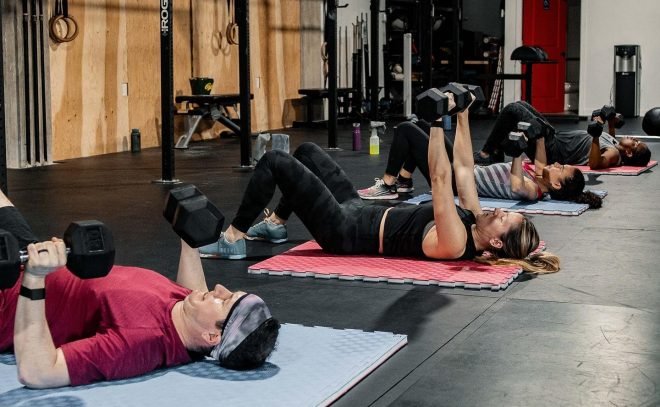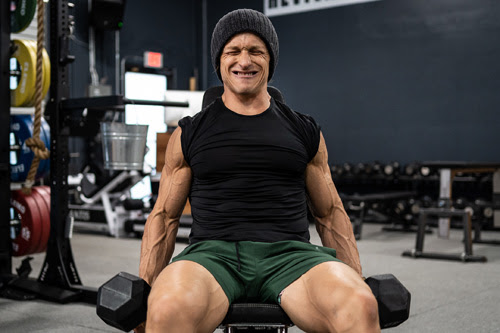5 Evidence Based Ways to Build Muscle

**This content has been edited from the newsletter from functional-bodybuilding.com**
We have clear indicators that our body requires much more and different types of movement than are currently considered “normal” for the average person.
Move By Design is based on four simple parameters: Be Mobile, Lift Heavy, Go Fast, and Move Slow. They form the basic foundations for optimal human movement, health, and longevity.
This blog will focus on building more muscle as a part of the Life Heavy portion of Move By Design.
Build Muscle, Lose Fat
Want to put on some MUSCLE? Then I’m going to give you the exact recipe for what you need in your training to do just that.
Want to LOSE FAT? Guess what – hypertrophy will do that too.
The science of building muscle gets more and more refined all the time. With the vast network of fitness professionals all over the world sharing information constantly, we all have access to the best information all the time around training.
So building muscle is no mystery. You have to follow a recipe – and there are 5 evidence-based guidelines that are specifically intended for HYPERTROPHY. The rules start to change when you start looking at building maximal strength, work capacity, or sport-specific skills and fitness. But for the purpose of muscle building, these are the tried and true guidelines.
Cardio Shrinks Bodies – And Hypertrophy Shapes Them
To lose body fat without losing muscle, you want to train in the same fashion. If you burn lots of energy without resistance training such as with lots and lots of running, walking, elliptical, etc., your body will shrink and get smaller if you’re on a calorie deficit – but you won’t have muscle tone. And you might not feel all that strong either.
If you train with the intent to build muscle and combine that with a calorie deficit, you will lose fat, maintain muscle, and look fantastic. You will also likely feel your best and have the best chance at long-term success if you focus on hypertrophy for fat loss as opposed to increased cardio and calorie restriction only. More muscle also means better metabolism, so you can burn more calories at rest – which means you can eat a little more when you get to maintenance mode.
Let’s Be Real – There’s a Catch
One last very important point is that while the following guidelines are clear and relatively simple, building muscle and losing body fat is VERY HARD. The list that I’m going to give you will NEVER replace HARD WORK. To gain muscle or lose your body fat you are likely going to have to work harder than you ever have before. Once you get the body you want and build muscle you can maintain it much easier, but getting there is going to take doing something you’ve never done before.
This is where program design, methodology, and the training culture you are a part of plays such an important role.
- What training program allows you to apply the following guidelines day in and day out for years?
- Which training culture encourages you to work hard but not overdo things leaving you burnt out or injured?
- What methodology honors muscle-building methods while also helping you bulletproof your body so it is resilient and remains healthy?
- Does your training also have carryover to your life so that you not only LOOK GOOD but also MOVE WELL when it counts, in your day-to-day life?
These are some of the same principles we base Move By Design on.
OK, let’s dive in!
5 Science-Backed Ways to Build Muscle
1. Frequency – Train each body part 2x/week.
The goal would be to hit each muscle group two different times a week. That would mean chest 2x per week as well as glutes 2x per week. With Functional Bodybuilding programming, we don’t have body part splits – we use movement pattern splits.
We usually have two days of upper body training and two days of lower body training.
The 5th day is usually a mixture of smaller muscle groups that get seen only once throughout the rest of the week. We can change this movement pattern split from to time but we aim to keep the same concept of 2 focused days per body part each week.
- Upper/Lower Rest Upper/Lower
- Squat Pull/Hinge Push Rest Squat Pull/Hinge Push
2. Volume – 10-20 Sets/week per Body Part
The sweet spot for how much training volume we need is somewhere in the 10-20 set range per body part each week. This is a big range and will depend on your training age. Someone more advanced might need closer to 20 sets a week to see progress and growth. Someone who is new to training may only need 10 sets.
3. Effort – 1-3 RIR or 8-9/10 RPE
You need to work sufficiently hard to get an adequate training stimulus. What experience and research tells us is that you DO NOT need to go to failure.
In fact, stopping short of failure is just as effective for building muscle, and in the end, will likely be more effective as it will indirectly impact how consistent you can be.
- RIR – Reps in Reserve – How many reps did you have left in the tank at the end of a set? We are aiming for 1-3 reps.
- RPE – Rate of Perceived Exertion – on a scale of 1-10, with 10 being hardest, we want you to shoot for an 8-9.
- FORM FAILURE – going to form failure is the point at which you start to see deviations from perfect optimal form. This is usually right at the ideal RIR/RPE level. Going beyond this point is when we start to hit ABSOLUTE FAILURE and when your safety gets compromised.
- Place such a big emphasis on QUALITY. For safety, we encourage you not to lift past FORM FAILURE. It just so happens that this aligns with the RIR and RPE evidence.

The funnier the face, the higher the RPE
4. TEMPO – A 2-5 Second Eccentric is Ideal
CONTROLLING movement is something we preach all the time. In order to promote control, we always prescribe tempos with our lifts, i.e. dictating the speed of every portion of the lift in the workout notation.
- 2-5 second eccentrics are the sweet spot and where the bulk of our working sets sit.
- Occasionally we will explore tempos that include pauses and some that slow down the concentric too. These are tools to build better mind-muscle connections and positional strength in our athletes.
5. REP RANGE – How much weight do I need to lift?
Loading is a by-product of REP RANGE. If you are trying to achieve FORM FAILURE for 5 reps vs 10 reps you will have different weights on the bar. So what is best?
- 1-5 Reps – When you hit form failure in this rep range you tend to do a lot of Nervous System damage, which can make it hard to recover and will increase fatigue.
- 8-15 reps is a sweet spot for hypertrophy that doesn’t cause as much damage and fatigue, allowing you to recover faster and get back to training again.
- This rep range tends to promote loads that are ideal to help strengthen tendons (connect bones to muscles).
- If you focus on this rep range, you will build great tendon strength. This supports our goal of keeping you feeling bulletproof.
- 20-30 reps – Hitting form failure at this rep range will mean working at a much lower weight but this range can also cause delayed onside muscle soreness and be harder to recover from.
BONUS – REST PERIODS
How long should you rest between exercises in order to maximize your training benefit? The length varies slightly from exercise to exercise, but the sweet spot is often in the 2-3 mins range when we are training for Hypertrophy.
- If you need to do a minimum of 10 sets per body part every week as I stated above, then a 3min rest period is going to mean up to 30mins of resting per body part every week. That is a lot of time for someone who wants to be in and out of the gym in an hour.
- THE SUPERSET SECRET – by utilizing Supersets, we can get meaningful work done during rest periods. Some ways we get around this:
- SuperSet two movements back to back
- Perform Giant Sets
- Perform Compounding SuperSet
As I have stated a number of times, we follow these guidelines as they are the methods and guidelines that are proven to be most effective.
If it was just a matter of posting guidelines and following a simple plan then everyone would be JACKED and FUNCTIONAL.
In order to train effectively and safely, we must make sure we’re ready to take on more movement-related stress. More stress means more recovery.
That’s where our Life By Design approach to chiropractic care fits in. It’s inefficient and downright dangerous to drive a car that’s out of alignment… now think about the stress and healing that’s required for your body training at a higher level, especially if it’s not working efficiently.
At The Powerhouse, we focus on your Bio-Structural health to help reconnect your brain, body and charge up your nervous system to handle these additional stresses.
If you’re curious about where your level of function is currently at, schedule your complimentary case review with one of our doctors.